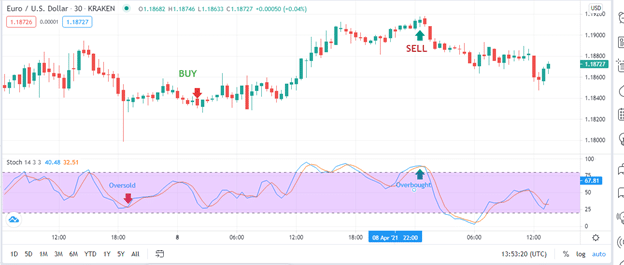The Stochastic Oscillator is an indicator that is used to establish whether or not a stock has been oversold or overbought. It does this by comparing the lowest and highest prices of a security over a specified period (usually 14) and the most recent closing price.
How it works and how it is read
The Stochastic Oscillator gives readings that are interpreted as a stock’s momentum on a scale between 0 and 100. The conventional 14 period is the standard analysis period and may represent months, weeks, or days.
The Stochastic Oscillator works on the principle that a price above or equal to the previous closing price represents an uptrend. Conversely, the downtrend is when prices move below the previous closing price.
Price action
The easiest way to assess stochastics oscillation is by looking at the price action; that is, by looking at the range between the day’s lowest recorded price and highest recorded price during a trading session. By looking at whether a stock is hovering near the day’s high or the day’s low, one can tell whether the stock is likely to pick an upward or downward trend.
The formula for calculating the Stochastic Oscillator is as shown below:
Formula
%k = (Last Closing Price – Lowest Price)/(Highest Price – Lowest Price) x 100
%D = 3-day SMA of %K
Where:
C is the last closing price.
The Lowest Low is the lowest low price for the chosen period.
The Highest High is the highest high price for the chosen period.
Strategic use of Stochastic Oscillator
Stochastic Oscillators are invaluable tools for traders. However, when used without considering other factors, they, by themselves, are not entirely sufficient for making good trading decisions. A single Stochastic Oscillator may achieve success the first time but fail in subsequent trading.
The best way to utilize these tools is by combining slow and fast stochastics. The slow stochastic is generated using moving averages while the fast stochastic is derived from the most recent prices.
What is the Stochastic Oscillator used for?
The Stochastic Oscillator is ideal when you want to do the following things.
Use crossovers for buying and selling
Crossovers are the points of intersection between the fast and slow stochastic lines, represented by %K and %D lines, respectively. A sell signal is sent when the %K line crosses the %D line and goes below it. On the other hand, a trader ought to buy when the %K line intersects with the %D line from below and moves above it.
Establish when a stock has been overbought or oversold
The Stochastic Oscillator’s momentum ranges between 0 and 100. Using this range, any reading above 80 is indicative of an overbought stock, while an oscillator level below 20 shows that the stock has been oversold.
Using the simple law of demand and supply while keeping one’s eyes on the oscillator movement, we can tell when to sell and when to buy a stock. When an oscillation goes above 80 before sliding back marginally below 80, then it’s time to sell. Conversely, when the oscillator goes below 20, followed by a reversal in movement past the 20 mark, that’s a signal to buy.
Know when to buy or sell using divergence
At times, the price may move to a new high or a new low, but the Stochastic Oscillator does not make a corresponding movement. This is called a divergence. There are two types of divergence, namely bullish and bearish divergence.
A bullish divergence refers to a situation where the price goes down, but this isn’t reflected on the Stochastic Oscillator. This can be interpreted to mean that the pressure to sell has cooled down, and price reversal is imminent. Conversely, a bearish divergence occurs when the buyers are reducing their activity, thereby setting the stage for a price reversal without affecting the Stochastic Oscillator.
While the oscillator gives a good indication of momentum, It is advisable for a trader not to trade until there is an actual change in the price to confirm the divergence.

Limitation of Stochastic Oscillators
While Stochastic Oscillators are useful in assessing the market momentum, they are not suitable for determining the trend for the long term, as they can send false signals. Instead, Stochastic Oscillators are appropriate for securities that have characteristically regular price swings.
Stochastic Oscillator vs. RSI
The Relative Strength Index (RSI) indicator shares a similarity with the Stochastic Oscillator in that both are used to show price momentum. However, the biggest difference is that the Stochastic Oscillator is premised on detecting the direction of the price movement based on the previous closing price. On the other hand, the RSI evaluates the market trend’s velocity.
Conclusion
As discussed above, the Stochastic Oscillator is a useful and popular indicator used by traders to establish how the market momentum is. Using signals read from divergence and crossovers, traders can detect reversal points to buy and sell. However, solely relying on overbought or oversold positions to buy and sell securities isn’t the smartest thing to do. Overbought positions can still translate into further purchases, while oversold positions may still result in more dumping of a stock. Other fundamentals always come into play.
It is therefore important that a trader considers all the important market fundamentals and implements them in their strategy. In addition, the oscillators should be used in combination with other indicators to the greatest extent necessary.
